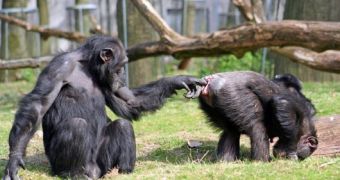They hunt with weapons, use stones and shelter in caves...And if you want more proofs of the relationship between people and chimps, a team at the Yerkes National Primate Research Center, Emory University, has come with another one.
It has been found that bonobos and chimpanzees make hand and feet gestures the way we do, more flexible than facial expressions and vocalizations. The new discoveries further enhance the gestural origin hypothesis of language, which states that the evolution of human language started with gestures.
The researchers made their observations on two groups of bonobos (13 animals) and two groups of chimpanzees (34 animals). They detected 31 manual gestures and 18 facial/vocal signals. While both species use facial/vocal signals in the same way, with the manual gestures it is a different story.
The hand gestures were found to have a more adaptable value as they seem to be less closely linked to a particular emotion and their message was more connected to the social context in which they were used.
"A chimpanzee may stretch out an open hand to another as a signal for support, whereas the same gesture toward a possessor of food signals a desire to share. A scream, however, is a typical response for victims of intimidation, threat or attack. This is so for both bonobos and chimpanzees, and suggests the vocalization is relatively invariant," explained co-author Dr. Amy Pollick.
The common gestures in humans and chimpanzees reveal the common ancestry. The gestures are a more recent evolutionary achievement than facial expressions and vocalizations, as only apes and humans display them, but monkeys don't.
"A gesture that occurs in bonobos and chimpanzees as well as humans likely was present in the last common ancestor," said Pollick.
"A good example of a shared gesture is the open-hand begging gesture, used by both apes and humans. This gesture can be used for food, if there is food around, but it also can be used to beg for help, for support, for money and so on. It's meaning is context-dependent," added co-author Dr. Frans de Waal.
Bonobos were found to make more flexible gestures than the chimpanzees. Other researches, too, have detected a more complex behavior in this ape.
"Different groups of bonobos used gestures in specific contexts less consistently than did different groups of chimpanzees," said Pollick.
Both species were found to employ multi-modal communication, mixing gestures with facial expressions and vocalizations to make their point.
"While chimpanzees produce more of these combinations, bonobos respond to them more often. This finding suggests the bonobo is a better model of symbolic communication in our early ancestors," explained Pollick.

 14 DAY TRIAL //
14 DAY TRIAL //